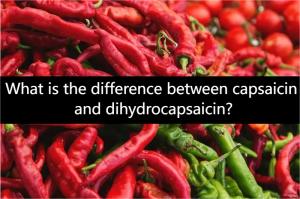What is the difference between capsaicin and dihydrocapsaicin?

When you taste the fiery heat of a chili pepper, you’re experiencing the work of fascinating chemical compounds called capsaicinoids. Among them, two key players—capsaicin and dihydrocapsaicin—create most of the burning sensation that chili lovers know so well. Although they are very similar in structure and effect, small molecular differences give them distinct physical and biological properties. Let’s explore these differences in detail and see why they matter.
1. Basic Definitions: The Star Compounds Behind the Heat
1.1 Capsaicin
Capsaicin is the most famous compound responsible for the heat in chili peppers. Chemically known as trans-8-methyl-N-vanillyl-6-nonenamide, it is a vanilloid-amide compound that interacts with the TRPV1 receptor in sensory nerves. When it binds to these receptors, the brain perceives heat or pain, even though the temperature has not changed. Capsaicin is colorless, odorless, and fat-soluble, which is why water does not relieve its burning sensation effectively.
1.2 Dihydrocapsaicin
Dihydrocapsaicin is another major capsaicinoid, often found alongside capsaicin in chili peppers. Together, they make up around 80–90% of the total capsaicinoids. Structurally, it is almost identical to capsaicin, with one key difference: dihydrocapsaicin has a fully saturated side chain, while capsaicin’s side chain contains a double bond. This slight change affects the molecule’s shape and physical properties, but not dramatically its pungency.
2. Chemical Structure: A Small Change That Makes a Difference
2.1 Structural Comparison
Both compounds share a vanillyl group linked to an amide and a long alkyl chain. The difference lies in the side chain’s saturation. Capsaicin’s chain has a double bond (making it unsaturated), while dihydrocapsaicin’s chain has only single bonds (making it saturated). This tiny difference means that capsaicin has a slightly bent structure, while dihydrocapsaicin’s structure is straighter and more flexible.
2.2 Impact of the Structural Difference
The presence or absence of a double bond can influence how each molecule interacts with biological membranes and receptors. Capsaicin’s unsaturated bond makes it slightly more polar, while dihydrocapsaicin is marginally more hydrophobic. These properties might subtly affect absorption and receptor binding, but both compounds activate the same sensory pathways and create a nearly identical sensation of heat.
3. Natural Occurrence and Proportions in Peppers
3.1 Where They Are Found
Capsaicin and dihydrocapsaicin are naturally produced in the Capsicum genus, which includes chili peppers of all kinds. The compounds are concentrated in the placental tissue—the white inner membrane where seeds attach—rather than the outer flesh. This is why removing the seeds and inner membranes can make a chili less spicy.
3.2 Proportions in Different Varieties
In most chili peppers, capsaicin accounts for about 60–70% of the total capsaicinoids, while dihydrocapsaicin makes up around 20–30%. However, these ratios vary depending on the pepper variety, growing conditions, and ripeness. Some species or green, unripe peppers may even contain more dihydrocapsaicin than capsaicin.
4. Pungency and Sensory Experience
4.1 How They Activate the Heat Receptor
Both compounds activate the TRPV1 receptor (transient receptor potential vanilloid 1), which detects physical heat and chemical irritation. When capsaicin or dihydrocapsaicin binds to TRPV1, it triggers nerve signals that the brain interprets as burning or heat. This is the same mechanism that helps explain why spicy food can make you sweat—it literally tricks your body into thinking it’s hot.
4.2 Are They Equally Hot?
Both compounds are extremely pungent, with nearly identical heat levels on the Scoville scale. Some studies suggest that dihydrocapsaicin may have a slightly lower threshold for triggering heat perception, meaning it can feel just a bit stronger in certain situations. However, in most foods, their burning sensations are indistinguishable to the human tongue.
5. Physical and Chemical Properties
5.1 Solubility and Stability
Capsaicin and dihydrocapsaicin are both fat-soluble and poorly soluble in water. This is why drinking water does little to ease the burn of chili—it spreads the compound rather than removing it. Fat-based foods such as milk, yogurt, or oils can dissolve these compounds better and reduce the heat sensation. Both are also stable under normal cooking temperatures, although prolonged heating can slightly reduce their potency.
5.2 Processing and Extraction
Food scientists and manufacturers often measure both compounds when determining the pungency of pepper extracts or spicy sauces. Because of their chemical similarity, they behave similarly during extraction, purification, and analytical testing, though small differences in polarity can influence the exact yield or solubility.
6. Biological and Health Effects
6.1 Shared Health Benefits
Capsaicin and dihydrocapsaicin share many physiological effects. They can boost metabolism, promote fat oxidation, and increase energy expenditure—properties that have made them popular in weight management research. Both compounds also exhibit anti-inflammatory and antioxidant effects, and are being studied for potential cardiovascular and pain-relief benefits.
6.2 Differences in Biological Impact
While most effects overlap, some studies suggest subtle distinctions. Dihydrocapsaicin may have slightly different bioavailability and may interact differently with certain enzymes. In very high concentrations, the compounds can show distinct toxicity thresholds, meaning their safe dose ranges could vary slightly in experimental or pharmaceutical applications.
7. Summary of Key Differences
Here’s a quick recap of what sets capsaicin and dihydrocapsaicin apart:
- Chemical Structure: Capsaicin has an unsaturated side chain (double bond); dihydrocapsaicin’s side chain is saturated.
- Physical Properties: Dihydrocapsaicin is slightly more lipophilic; capsaicin is marginally more polar.
- Natural Ratio: Both appear together, with capsaicin usually being more abundant.
- Pungency: Both have similar heat intensity and act on the same receptors.
- Biological Effects: Nearly identical, though minor variations may exist in metabolism and toxicity thresholds.
In essence, the two molecules are chemical siblings—so similar that your taste buds can’t tell them apart, yet unique enough to matter in scientific and industrial contexts.
8. Practical Insights for Everyday Life
For cooks, nutrition enthusiasts, or spice lovers, understanding the difference between capsaicin and dihydrocapsaicin can add a new layer of appreciation to your culinary experiences. Both are responsible for the “heat” that defines spicy food, but knowing how they behave helps in creating or moderating that burn.
- Milk or dairy works better than water for cooling spice because both compounds are fat-soluble.
- Different pepper varieties have different ratios, explaining why some burns feel faster or linger longer.
- In medical creams or supplements, both compounds may be used together to provide pain relief or boost circulation.
In conclusion, capsaicin and dihydrocapsaicin are nearly identical in the way they deliver heat, yet their tiny structural difference makes them scientifically fascinating. Whether you study chemistry, develop food products, or simply enjoy a good chili challenge, knowing the difference deepens your understanding of why spicy food feels the way it does—and reminds us how a small molecular twist can create a world of sensation.


